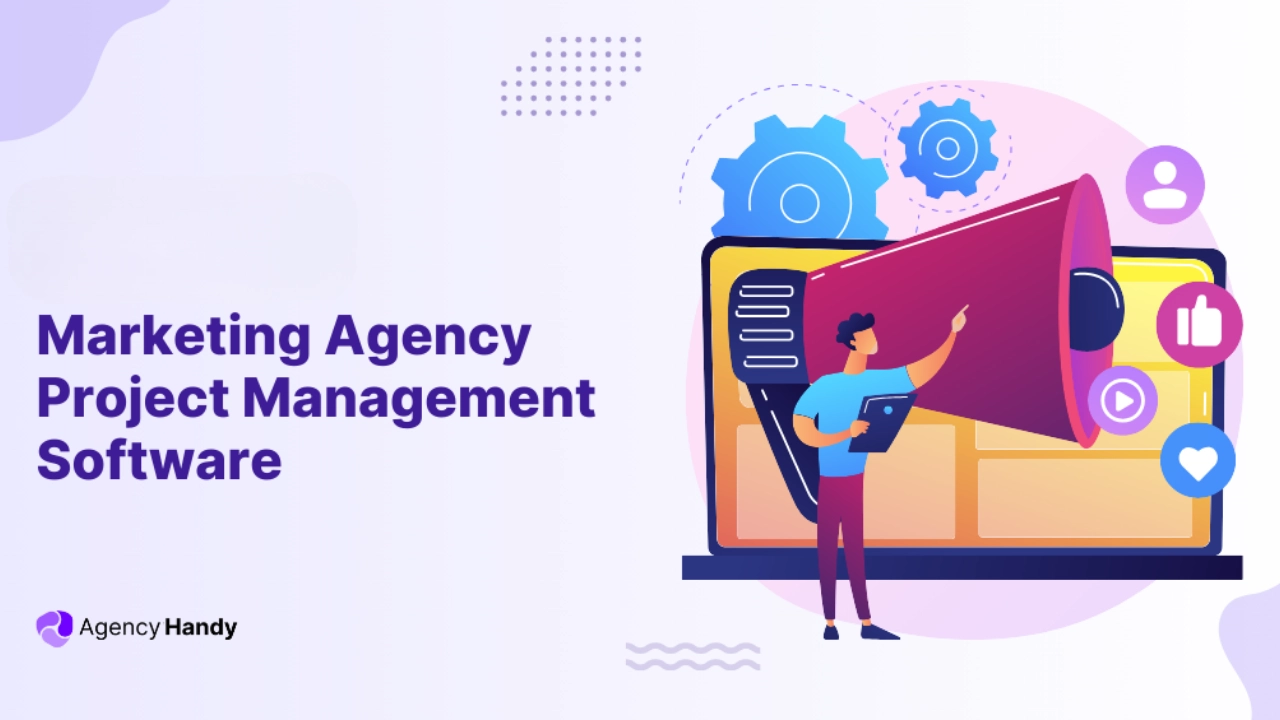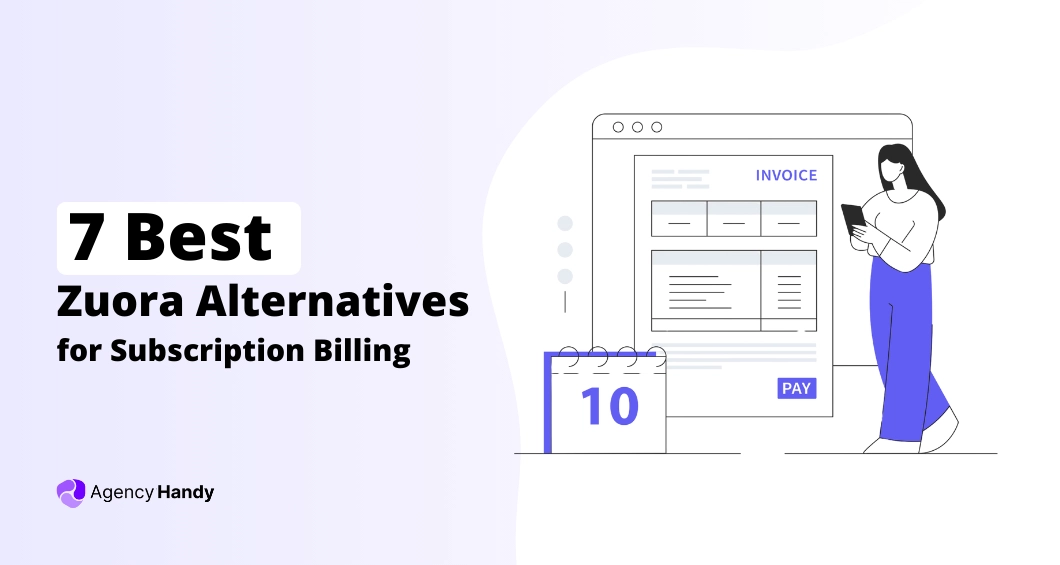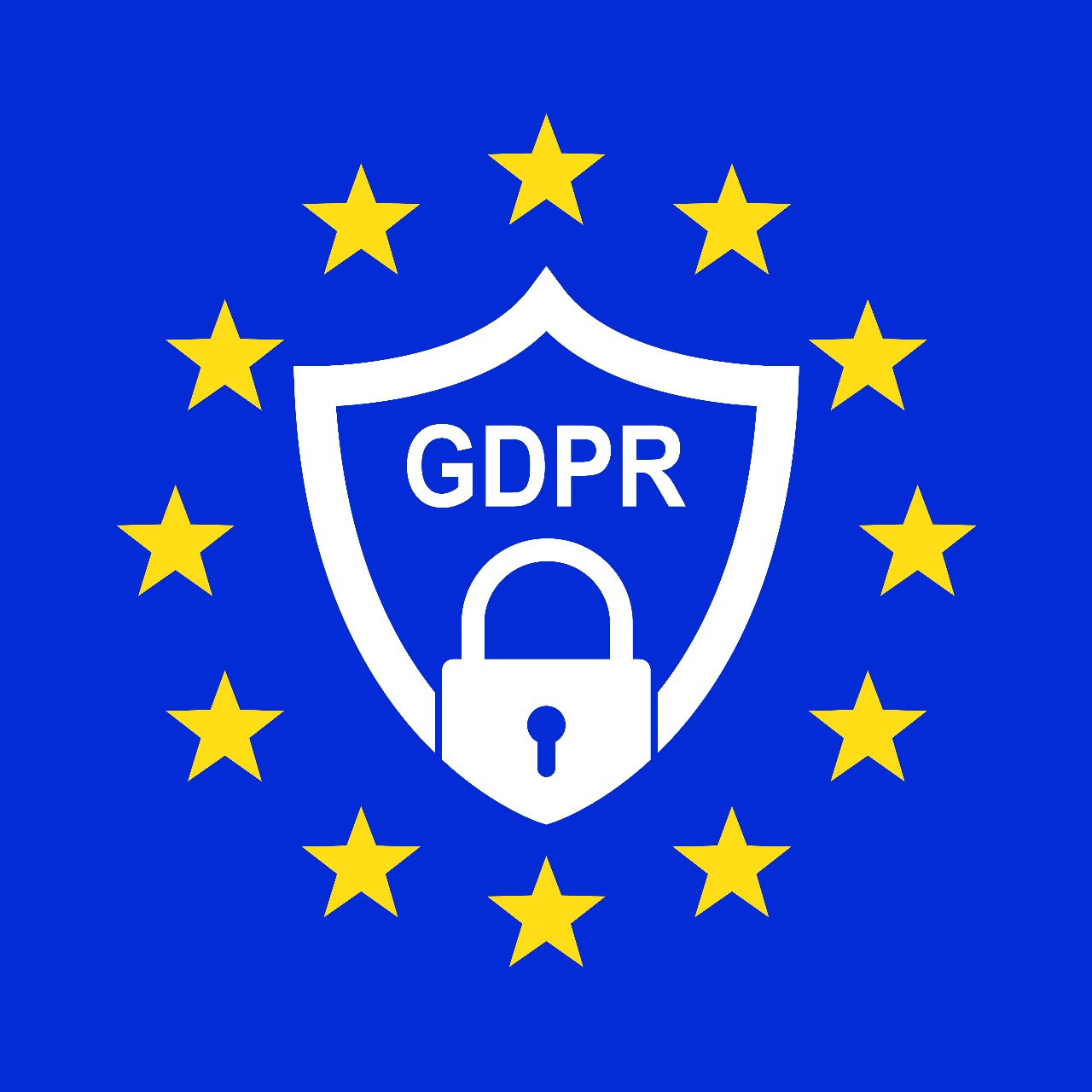We basically started as a client portal software. But from the beginning, we also let our clients manage their projects. Over the past few years, the workflow has been like this –
The portal creates tasks, clients upload necessary files, check updates, communicate with the team, give file feedback, and get the final deliverables.
Clients these days prefer self-service rather than knocking each time they need something. That’s where a project management and client portal comes in handy for agencies.
We have tested dozens of project management portals, and here are the top 10 we even took inspiration from.
Quick List of Top Project Management Software with Client Portal
- Agency Handy: An all-in-one PM and client portal for agencies of all sizes.
- Bonsai: Connects simple project management directly to a professional client portal.
- Productive: A PM platform with a transparent client portal for tracking project budgets.
- ManyRequests: A white-label portal for productized agencies to manage client service requests.
- SuiteDash: An all-in-one with an extremely customizable, white-label client portal.
- HoneyBook: A clientflow platform for solopreneurs with a professional, branded client portal.
- Dubsado: An automation-first platform for solopreneurs, with a portal for client workflows.
- Kitchen.co: A simple, folder-based PM and client portal with flat-rate pricing.
- 17hats: An all-in-one tool for solopreneurs to manage projects, docs, and clients.
Top 9 Project Management Client Portal Tools [And Overviews]
In the list, we have included both top-tier and mid-tier Project Management Portals suitable for small businesses, agencies, and even freelancers.
| Tools | Price (Monthly) | Project Management | Team & Client Collab | File Feedback (Annotations) | Version Control |
| Agency Handy | $19 – $199 | Kanban board | Task-based messaging & client portal | ✅ | ✅ |
| Bonsai | $15 – $59 (per user) | Kanban & List views | Direct messaging & client task approvals | ❌ | ❌ |
| Productive | $11 – $39 (per user) | Gantt, Kanban, List, Table | Centralized comments & client dashboards | ❌ | ❌ |
| ManyRequests | $29 – $99+ (base fee) | Kanban, List, & Queue views | Centralized client messaging | ✅ | ❌ |
| SuiteDash | $19 – $99 (flat fee) | Task management | Secure messaging & dynamic dashboards | ❌ | ❌ |
| HoneyBook | $36 – $129 (flat fee) | Simple task lists (Pipeline) | Centralized messages & client tasks | ❌ | ❌ |
| Dubsado | $20 – $40 (flat fee) | Simple task lists (Workflows) | Client portal hub for forms & files | ❌ | ❌ |
| Kitchen.co | $29 – $299 (per user) | Kanban boards | Integrated project conversations | ✅ | ❌ |
| 17hats | $60 (flat fee) | Simple task lists (Workflows) | Portal for document & file access | ❌ | ❌ |
1. Agency Handy
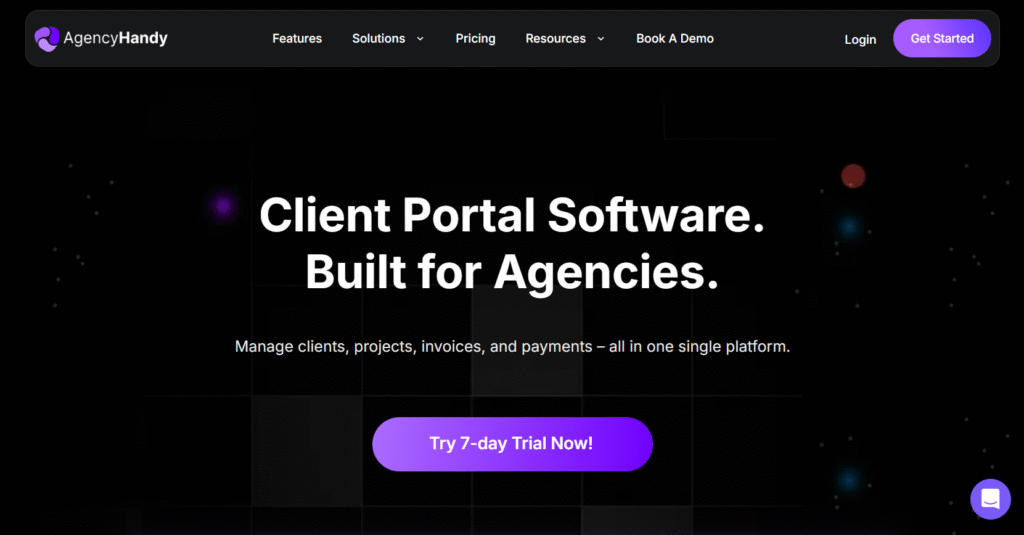
Agency Handy makes sure your clients are properly aware of the projects you’re working on for them. Our client portal makes projects transparent, keeps files organized, and streamlines client communication so nothing slips through the cracks.
At the heart of it is a visual Kanban board. Tasks move through clear stages like pending, in progress, in review, and complete. Both you and your clients see updates in real time. When a task is finished, it goes straight to the review stage. Clients can log in, check the work, and approve it without sending a single email.
Feedback is no longer vague. With built-in annotation tools, clients can drop comments directly on files. They can highlight, add arrows, leave notes, and pinpoint exactly what needs to be changed. This is a huge time-saver for creative work like design, video, content, or marketing.
Clients can also upload their own files, like brand assets, documents,and reference materials, into the portal. Everything is stored in one place, alongside project updates and communication threads, making collaboration smoother and more professional.
Agency Handy Features
To make sure your team stays busy doing projects, rather than admin stuff, here’s what Agency Handy has to offer –
Project View

This is the most selling point of our project management feature. The goal is to keep your list of tasks well-organized so that nothing is overlooked. The board got 4 lists for task flow to simply drag and drop: pending, in-progress, review, and complete.
For each project, you can set the expected delivery date. This ensures both your team and clients are aware of it.
Real-time Project Updates
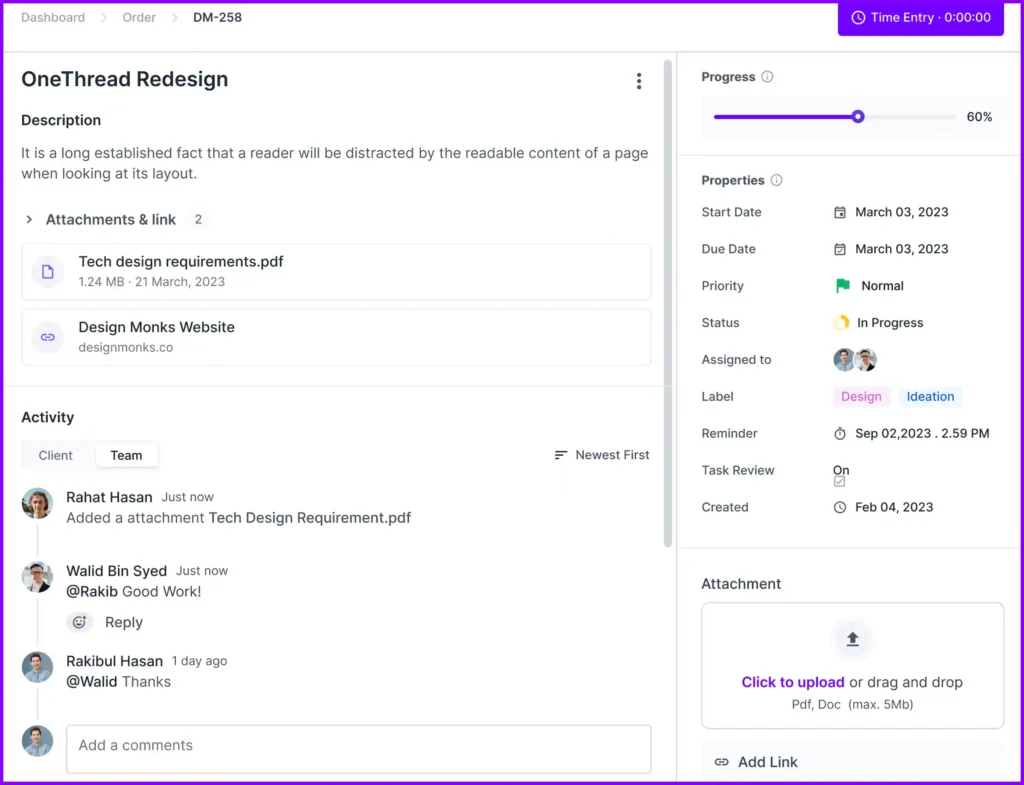
Agency Handy lets your client see real-time project updates. No need to follow up with clients frequently. This is extremely useful when you have a lot of clients and a few dozen tasks are in progress.
Task Creation
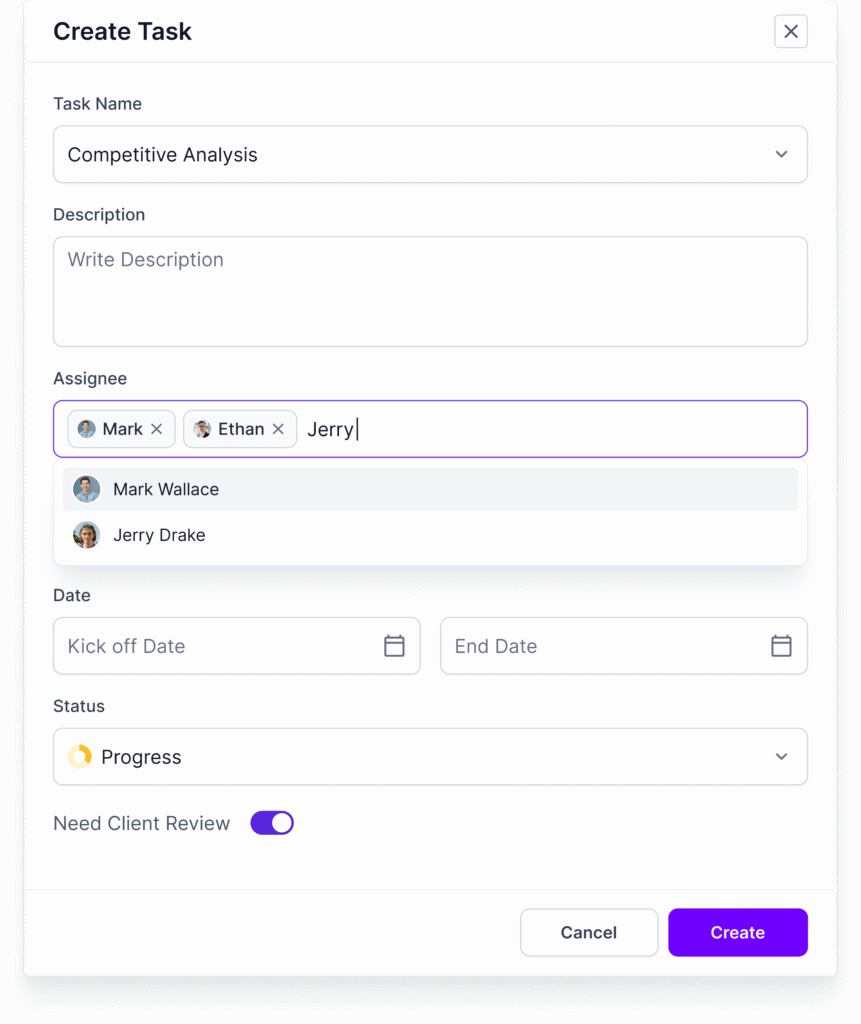
Regardless of how many clients you onboard and how many orders are created, Agency Handy automatically adds tasks to the projects as per your services.
File Feedback and Version Control

As clients will give feedback on files, there will be multiple file versions. If there is any need to restore to any specific version, you can do that as well. Our project tool manages all files related to tasks.
Time tracking

In the project management tool, you will have several team members dealing with tasks. You can track their work time and prepare a timesheet. You can monitor their performance and identify if there are any underperformance issues.
File Uploads
Clients can upload brand assets, reference materials, or documents straight into the portal. Everything lives in one organized place, so you don’t have to dig through inboxes or shared drives just to find the right file.
Built-In Messaging
During tasks, clients might need to communicate with your team and vice versa. Clients can send quick messages, ask questions, or follow up without jumping to email or chat apps. Conversations are tied to the work, so nothing slips away.
No-signup Client Portal
Once a client pays, they immediately get a welcome email with a secure portal link. There’s no manual setup and no waiting around — they log in and see their projects, tasks, and files right away.
White-Labeled Client Portal Experience

Clients don’t feel like they’re using a third-party tool. The portal carries your logo, colors, and custom domain, making it look and feel like your own platform. It builds trust and gives your freelance work a professional edge.
Invoices & Payments

Clients can check invoices, make payments, or manage subscriptions directly from their portal. With Stripe, Wise, and bank transfer options, the process is smooth for them and reliable for you.
Support Tickets
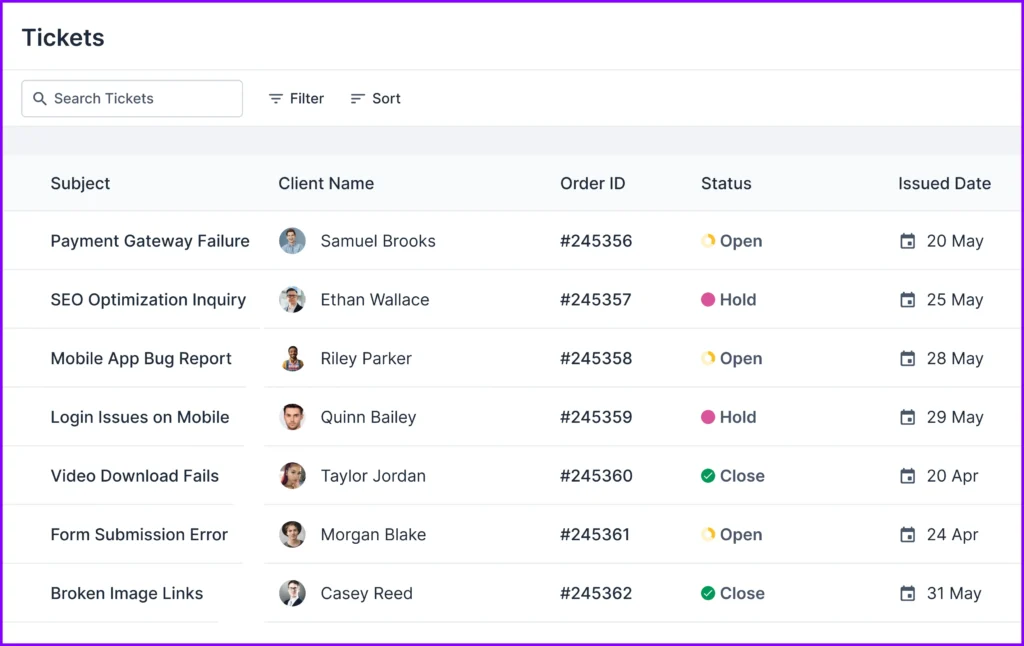
If clients run into issues or have requests, they can raise a ticket inside the portal. This keeps support structured, instead of scattered across random emails, and gives them a clear way to track resolutions.
Other worth mentioning features from Agency Handy are as follows –
- CRM
- Multipackage service catalog
- Intake and order forms
- Proposals
- Invoice and subscription
- Custom forms
- White-labeling
- Custom email and domain
- Webhook
- Slack integration
Best Use Cases of Agency Handy
Now, let’s have a look how Agency Handy using would be like in various fields –
- Freelancers
Manage unlimited clients and projects in one place. White-label the portal for a branded experience, automate onboarding, tasks, and invoices, and cut out the messy back-and-forth.
- Small to Mid-Sized Agencies
Assign tasks across your team, track progress on Kanban boards, and give clients real-time project updates. Service catalogs and subscription billing make scaling easier.
- Creative Studios (Design, Photography, Video)
Use annotation tools for precise feedback on designs, photos, and video edits. Clients mark changes directly on files, speeding up revisions and approvals.
- Event & Marketing Teams
Track every moving part of a campaign or event — from banners to catering — with tasks and deadlines visible in the portal. Clients see real-time progress without constant follow-ups.
- Specialized Agencies
For video, content, or IT teams, the structured workflow (pending → in progress → review → complete) keeps projects clear. Clients upload files, give feedback, and approve work inside the portal.
What Users Say About Agency Handy
G2: 4.9 out of 5
“I really like how Agency Handy keeps everything in one place—it makes managing tasks and tracking team hours super easy. The proposal tool is awesome too. It lays out all the package options in a way that makes sense to clients, and then it automatically creates tasks for my team based on what they select. It honestly saved me so much time.” – Sheena S.
Capaterra: 4.5 out of 5
“Agency Handy is an all-in-one solution that has streamlined our operations, improved client satisfaction, and boosted team productivity. It’s an indispensable tool for any digital agency looking to scale their business efficiently.” – Priyanka P.
Agency Handy Pricing
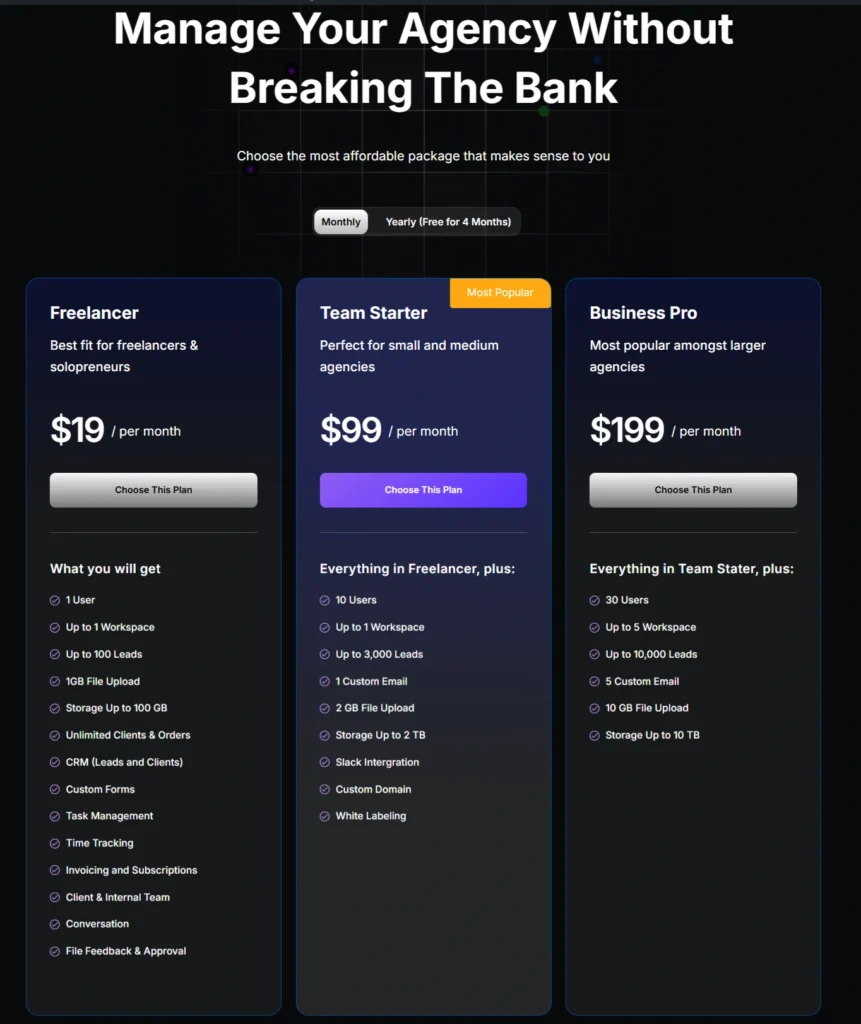
Freelancer
- Monthly: $19/mo
- Yearly: $13/mo
Team Starter
- Monthly: $99/mo
- Yearly: $66/mo
Business Pro
- Monthly: $199/mo
- Yearly: $133/mo
2. Bonsai

Agency project managers waste hours copying and pasting client feedback from emails into their actual project plans.
Bonsai solves this by directly combining its project management tools with a branded client portal, creating one place to manage both the work and the client conversation.
It’s built for freelancers and small agencies that want to give their clients a professional, self-serve experience. The whole idea is to unify your internal project tracking with your external client communication.
The standout feature is its branded client portal, which gives your clients one organized hub to see project progress, find files, and approve work.
This portal is powered by its Integrated Task Management, letting your team track tasks and time internally while seamlessly sharing progress with the client.
Bonsai Features
- Branded client portal for project access.
- Task management with Kanban and list views.
- Resource planning and workload management.
- Time tracking on projects and tasks.
- Centralized file sharing for teams and clients.
- Direct messaging within the client portal.
- Client task visibility and approvals.
- Project templates for agency workflows.
- Real-time project progress tracking.
- Intake forms to turn requests into projects.
Pros
- Reduces back-and-forth client emails.
- Gives clients a professional, self-serve experience.
- Directly connects your internal tasks to client visibility.
- Simple PM tools are easy for teams to adopt.
- Resource planning helps manage your team’s capacity.
Cons
- Average project management capabilities
- Lacks deep, internal-only team collaboration features.
Bonsai Pricing
Basic
- Monthly: $15/user/month
- Yearly: $9/user/month
Essentials
- Monthly: $25/user/month
- Yearly: $19/user/month
Premium
- Monthly: $39/user/month
- Yearly: $29/user/month
Elite
- Monthly: $59/user/month
- Yearly: $49/user/month
3. Productive.io
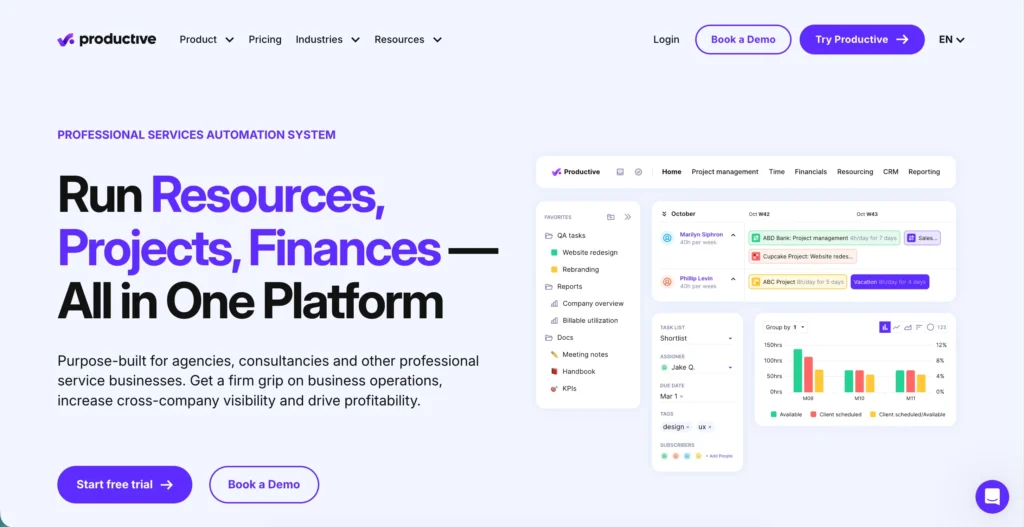
Productive is built for established agencies that want to solve budget and resource allocation.
Its whole approach is to be a project management platform that deeply integrates financial visibility into the client experience. One of its best features is the white label client portal, which is different from most because you can give clients a live view of their project’s budget and burn rate.
The best part is that the client portal isn’t separate from your real work. It’s directly fed by your team’s internal task and resource planning. This means what your client sees is always in sync with what’s actually happening.
Features
- Client portal with custom permissions.
- Custom dashboards for client reporting.
- Task management with multiple project views.
- Resource planning and workload views.
- Integrated time tracking on tasks.
- AI-powered documents for project briefs.
- Forms for client feedback and requests.
- Workflow automations for project tasks.
- Project templates for recurring agency work.
- Centralized comments and collaboration.
Pros
- The client portal offers best-in-class transparency.
- Connects your internal resourcing to project timelines.
- Centralizes client feedback and communication on tasks.
- Project management tools are robust and powerful.
- Inviting clients to collaborate is free.
Cons
- Overkill for simple task management.
- Has a learning curve
Productive.io Pricing
Essential
- Monthly: $11/user/month
- Yearly: $9/user/month
Professional
- Monthly: $28/user/month
- Yearly: $24/user/month
Ultimate
- Monthly: $39/user/month
- Yearly: $32/user/month
4. ManyRequests

Running a productized or subscription agency is a totally different ballgame than traditional project work. If your agency needs a system for clients to submit requests and manage their subscription, you should look at ManyRequests.
It’s built specifically for agencies that offer services like “unlimited design” or “unlimited video editing.” The platform’s whole purpose is to be a white-label client portal designed to manage a high volume of client requests.
Another game-changer is its Request Queue Management, which is built for the subscription model and lets you easily manage incoming work for your team.
Features
- Fully white-label client portal.
- Custom domain and email branding.
- Client request management (List, Kanban, Queue).
- Built-in design and video proofing.
- Customizable request forms with conditional logic.
- Centralized client messaging and files.
- Brand asset profiles for clients.
- Time tracking on individual requests.
- Team performance and request analytics.
- Client self-serve sign-up pages.
Pros
- Perfectly designed for the productized agency model.
- Extensive white-labeling creates a professional look.
- Simplifies the client request and feedback process.
- Built-in proofing is a huge plus for creative work.
- Lets clients manage their own subscriptions easily.
Cons
- PM features are less robust than dedicated tools.
- Expensive when you add members
Many Request Pricing
Starter
- Monthly: $29/month/seat
- Yearly: $19/month/seat
Extra Seat (max 2 seats total): $20/month
Core
- Monthly: $59/month/seat
- Yearly: $39/month/seat
Extra Seat: $20/month
Pro
- Monthly: $99/month/seat
- Yearly: $79/month/seat
Extra Seat: $30/month
Enterprise
- Custom pricing for teams over 25.
5. SuiteDash
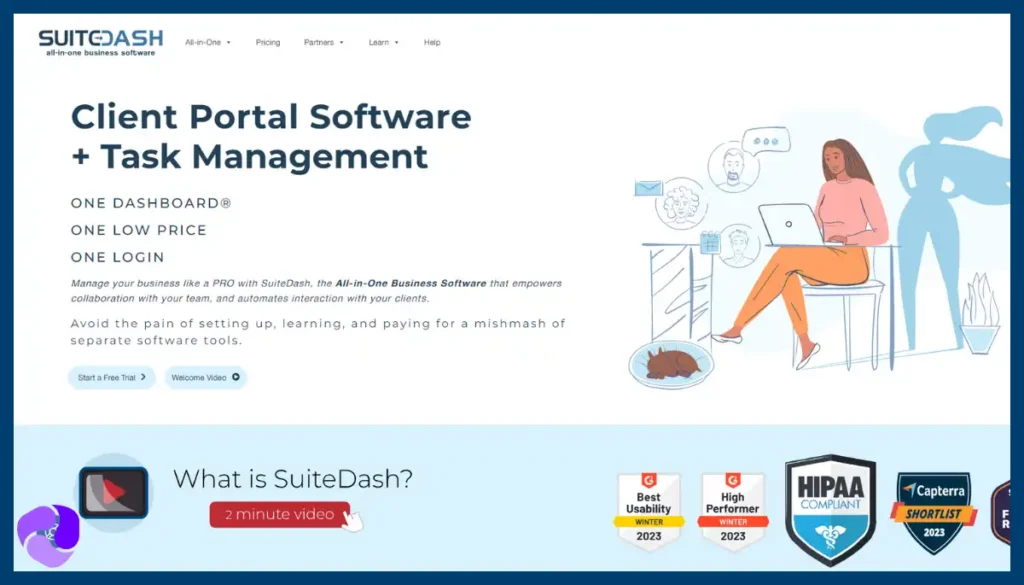
Many agencies are tired of paying for a dozen different tools that don’t talk to each other. If you want to bring your projects, files, and client communication into one affordable platform, you should look at SuiteDash.
It’s built for agencies that want a single system to run their entire business, with a heavy emphasis on the client experience. SuiteDash client portal is highly customizable for every business’s needs.
What makes it stand out is its Extreme White-Labeling; you can use your own URL, your own branding, and even a custom mobile app so clients never see the SuiteDash name.
Another powerful feature is its Dynamic Client Dashboards, which let you build a unique, personalized homepage for each client showing them just their projects, files, and data.
Apart from features, SuiteDash support is quite impressive to this day.
Features
- Fully white-label client portal.
- Custom URL and branded mobile app.
- Dynamic and customizable client dashboards.
- Project and task management system.
- Secure file exchange and client uploads.
- Secure messaging with clients and staff.
- Custom forms for project intake.
- “Magic Link” password-less login for clients.
- Custom menus based on user roles.
- Embeddable content from other apps.
Pros
- Unmatched white-labeling for a truly branded experience.
- Dynamic dashboards create a unique portal for each client.
- Consolidates many tools, which can save a lot of money.
- “Magic Link” login is a great touch for clients.
- Very affordable for the sheer number of features you get.
Cons
- Average project management tool
- Dated user interface
SuiteDash Pricing
Start
- Monthly: $19/month
- Yearly: $180/year
Thrive
- Monthly: $49/month
- Yearly: $480/year
Pinnacle
- Monthly: $99/month
- Yearly: $960/year
6. HoneyBook
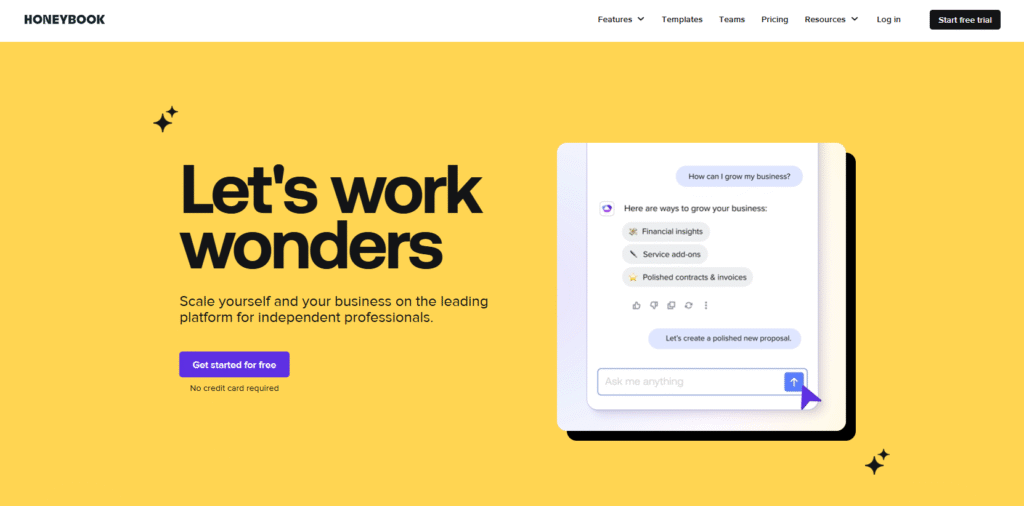
When it comes to creating proposals, contracts, and managing clients, HoneyBook is a go-to option as a client service management software. It’s built for solo operators and small creative businesses that want one simple platform to manage their entire client journey.
One of its best features is the Branded Client Portal, which gives your clients a beautiful, professional hub to find files, see updates, and communicate with you. You’ll also love the ability to assign tasks directly to your clients, which is perfect for getting the feedback and files you need from them on time.
Features
- Customizable and branded client portal.
- Custom domain for portal access.
- Assignable tasks for clients with due dates.
- Centralized project files and messages.
- Project pipeline to track all clients.
- Time tracker for logging billable hours.
- Integrated calendar and meeting scheduler.
- Automated client workflow steps.
- AI tools for meeting notes and recaps.
- Project activity feed for real-time updates.
Pros
- Proposal and contract templates are easy to go
- Keeps all client communication and files in one place.
- Assigning tasks to clients keeps projects on track.
- The interface is clean, modern, and very easy to use.
- Automations help streamline the entire client journey.
Cons
- Very basic project management tool
- Expensive for teams
HoneyBook Pricing
Starter
- Monthly: $36/month
- Yearly: $29/month
This plan is for one user
Essentials
- Monthly: $59/month
- Yearly: $49/month
This plan includes up to 2 team members
Premium
- Monthly: $129/month
- Yearly: $109/month
This plan includes unlimited team members
7. Dubsado
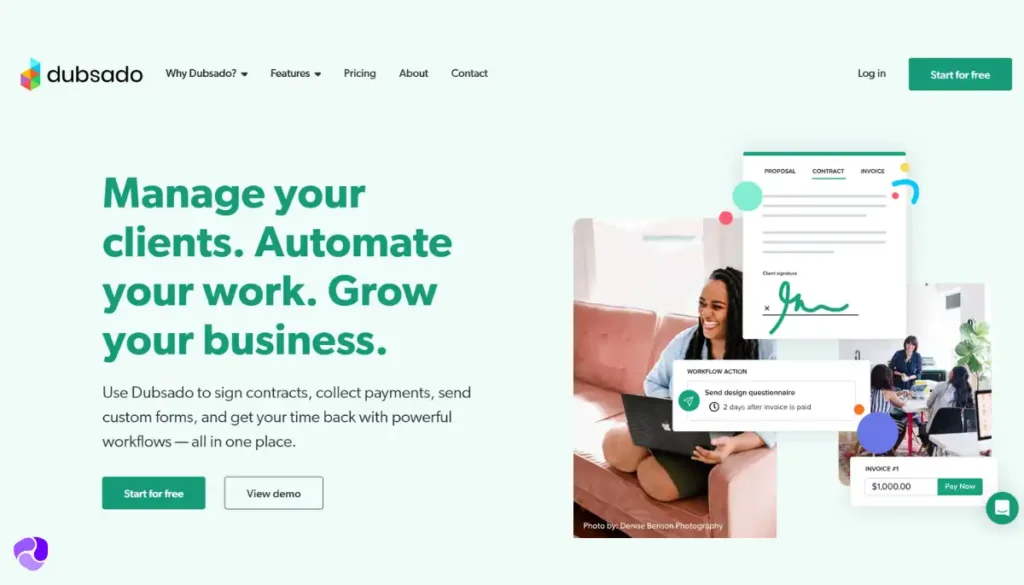
A lot of creative freelancers find themselves drowning in admin, manually sending the same emails and forms for every single client. If you’re a solo business owner who wants to get organized and look professional, you need to look at Dubsado.
It’s built for creative solopreneurs who want to stop reinventing the wheel and automate their entire client process. Its real power comes from being an automation-first platform for managing your client flow.
The most important feature is its Automated Workflows, which let you set up a complete journey for your client, from automatically sending a welcome packet to activating their portal.
This all ties into the Client Portal, a clean, professional hub where your clients can find all their project files, forms, and updates in one place.
Features
- Automated client workflows.
- Branded, password-protected client portal.
- Project status and pipeline tracking.
- Dynamic to-do lists for tasks.
- Custom forms and client questionnaires.
- Centralized client communication hub.
- Integrated meeting scheduler.
- Mobile app for on-the-go management.
- Zapier integration for other apps.
- Project and goal-tracking dashboards.
Pros
- Powerful automations save a massive amount of admin time.
- The client portal provides a seamless, professional experience.
- It’s built specifically for a creative solopreneur’s workflow.
- Consolidates many tools (scheduling, forms, projects) into one.
- Automating the client onboarding process is a huge win.
Cons
- It is not a team-based project management tool.
- Has a very steep learning curve to set up automations.
- Lacks deep PM features like Gantt charts or resource planning.
- Built for a business-of-one, not a growing agency team.
Dubsado Pricing
Starter
- Monthly: $20/month
- Yearly: $200/year
Premier
- Monthly: $40/month
- Yearly: $400/year
8. Kitchen.co
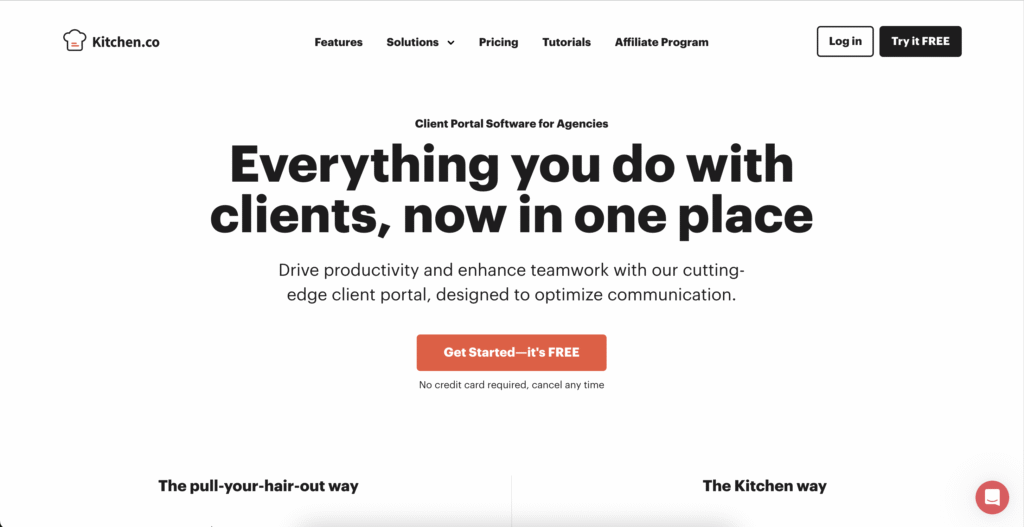
Many agencies find that their client work gets scattered across chat apps, email, and task lists, creating a disorganized mess. If your team needs a simple and intuitive way to bring all your projects and client communication together, you should look at Kitchen.co.
It’s built for freelancers and small agencies that want one central hub for everything. The platform is built on a simple premise: organize your agency like you organize your computer.
What makes it different is its intuitive Folder-Based Organization; you can structure everything by client or project in a way that just makes sense.
As an ideal freelance project management app, Kitchen.co combines Conversations and Kanban Boards, keeping your team’s project talk right next to the project tasks so nothing gets lost in translation.
Features
- Folder-based organization for projects.
- Kanban boards for task management.
- Centralized conversations with email sync.
- File exchange with client uploads.
- Built-in document creation and sharing.
- File feedback and approval tools.
- Embed tabs for third-party apps.
- White-labeling with custom domain.
- Selective folder sharing with clients.
- Nested folders and color-coding.
Pros
- The folder-based system is incredibly intuitive and easy to learn.
- It keeps project tasks and conversations together.
- The free and lifetime plans offer incredible value.
- Embedding other tools adds a lot of flexibility.
- White-labeling provides a professional client experience.
Cons
- Lacks advanced PM features like Gantt charts.
- Not built for highly complex projects with dependencies.
- Fewer native integrations than larger platforms.
- Less powerful than using separate, best-in-class tools.
Kitchen.co Pricing
Agency White-label
- Monthly: $29/user/month
Lifetime
- 5 Users: $299 (one-time payment)
- Unlimited Users: $599 (one-time payment)
9. 17hats
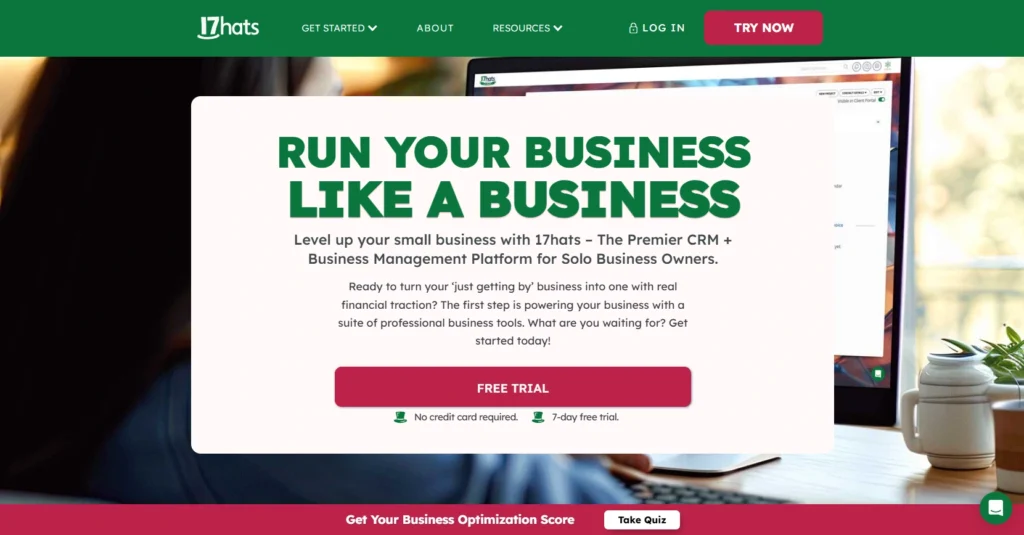
Many freelancers and solo business owners find themselves drowning in sticky notes and spreadsheets, which makes it hard to look professional to clients. If you’re a “solopreneur” trying to manage all the different hats in your business, you should look at 17hats.
It’s built specifically to bring organization and automation to a business-of-one. The platform’s whole idea is to be an all-in-one system to manage your entire client workflow from start to finish.
One of its best features is the Client Portal, which gives your clients a simple, secure place to access their project documents and key information.
You’ll also love its To-Do Workflows, which let you create and automate repeatable checklists for every client, ensuring you never miss a step in your process.
Features
- Client portal for document access.
- Project pages to organize client work.
- Centralized to-do list management.
- Automated to-do list workflows.
- Integrated calendar for project dates.
- Project notes and communication tracking.
- Branded portal with your custom logo.
- Email integration within projects.
- Online meeting scheduler.
- Actionable dashboard for daily overview.
Pros
- Brings all your client projects and files into one place.
- The client portal provides a simple, professional hub.
- Automated workflows help standardize your process.
- The dashboard gives a clear overview of your day.
- Designed specifically for a solo business owner’s needs.
Cons
- Project management tools is very basic
- It is not designed for team collaboration.
17hats Pricing
- Monthly: $60/month when billed monthly.
- Yearly: $600/year when billed annually.
- Bi-Yearly: About $800/two years when billed every two years.
Key Considerations for a Project Management Client Portal Software
When you’re looking for a single tool that does both, you’re not just buying a task list; you’re buying a more professional and efficient way to work with your clients. Here’s why those features are so important for an agency:
- Self-service Client Portal: This is the whole point. You want a portal where clients can help themselves. They should be able to log in anytime to upload files, find files, see project status, give file feedback, all without having to ask you for an update.
- Kanban Board View: This gives your team and your client a quick, visual way to see a project’s status. Being able to drag a task from ‘In Progress’ to ‘Client Review’ is a simple, clear way to show you’re getting work done.
- Real-time Project Updates: The main goal is to stop the endless “just checking in” emails. Look for a tool with a live activity feed so your client can log in and see the project status.
- Team and Client Collab: The tool must have a clear separation between internal-only comments (for your team) and client-visible conversations. This lets your team collaborate freely while keeping all client communication organized and on record.
- File Uploads: This replaces the messy Google Drive or Dropbox folder. You need one central, organized place for all project files, briefs, and deliverables that both you and your client can easily access.
- Client Task Creation: This is about keeping clients accountable. You need the ability to assign tasks to your client, like “Approve this mockup” or “Upload the brief,” with a clear due date to keep the project from stalling.
- File Feedback with Annotation Tools: This is a must-have for creative agencies. It’s the difference between a vague email and letting your client circle the exact part of a design they want changed. It provides total clarity and cuts revision time in half.
- Version Control: This feature solves the “final_v3_final_FINAL.jpg” nightmare. It keeps a clear history of all file revisions, so your team and your client are always looking at the most current version.
- Time Tracking: This is how you protect your profit. By tracking time directly against tasks and projects, you can see if a client or project is profitable in real-time and build trust by sharing accurate time reports.
Conclusion
For a project management client portal software, the purpose is typically to manage projects and link them to clients while managing clients. By managing clients, I mean get them a self-service client portal where they don’t have to ask your team again and again.
Agency Handy checks all boxes, being an affordable project management portal. You can try it for free for 7 days without a credit card.
Frequently Asked Questions
1. What is a project management client portal?
A client portal is a secure, private, and branded online hub where your clients can log in. It gives them one central place to track project progress, access shared files, sign off on work, and communicate with their team.
2. Why use a client portal instead of just email?
A client portal keeps all project-related communication and files organized in one place, ending the chaos of endless email chains. It provides a single source of truth so nothing gets lost, and it makes your business look far more professional.
3. What features should a good client portal include?
Look for a real-time project tracker, a central file-sharing system, a way to get client feedback and approvals (like annotation tools), and the ability to assign tasks to your client (like “Upload brand assets”).
4. Is a client portal the same as project management software?
Not exactly. The project management software is the “back-end” for your internal team to manage work. The client portal is the “front-end” that your client sees. The best platforms combine both, so your internal work automatically updates the client portal.
5. Can my clients see my internal team’s conversations?
No. A good client portal gives you full control. It will have a clear separation between private, internal-only comments for your team and separate, client-visible conversations, so you never have to worry about a client seeing messy internal notes.




